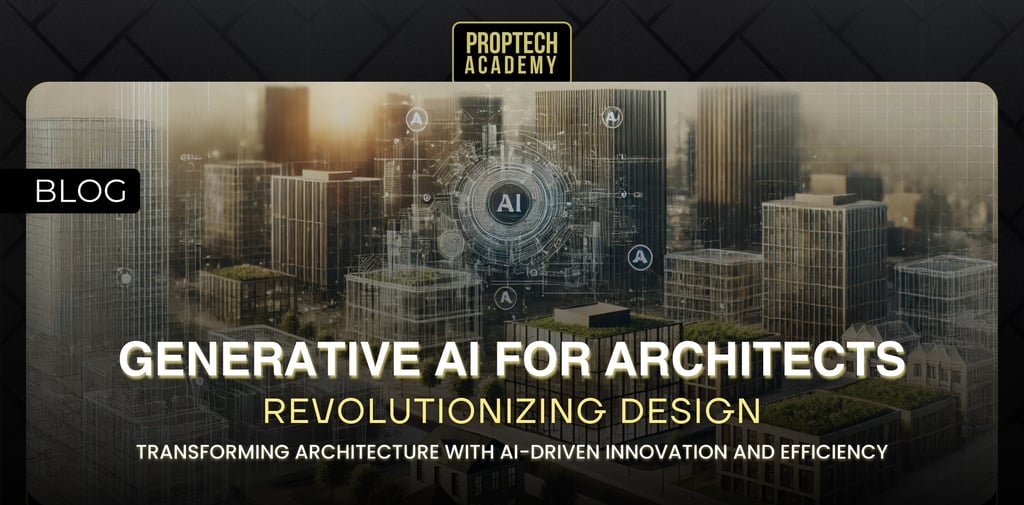Generative AI for Architects
How AI is Revolutionizing the Architecture Industry
PropTech Academy
2/19/20253 min read


How AI is Revolutionizing the Architecture Industry
The field of architecture is undergoing a technological transformation like never before. With the rise of Generative AI for Architects, designing and planning buildings has become more efficient, creative, and data-driven. AI-powered tools allow architects to generate multiple design options, optimize structures, and create environmentally sustainable buildings.
From concept development to final execution, AI is reshaping the way architects work. Whether it’s AI tools for urban planning or AI-driven building designs, artificial intelligence is making architecture smarter and more efficient. This shift is not just a trend—it is the future of architecture.
How AI is Changing the Architectural Landscape
Traditional architectural design involves manual drafting, time-consuming calculations, and repetitive revisions. However, with the introduction of Generative AI for Architects, these processes have become significantly more automated and precise. AI tools can now:
Generate multiple design variations based on specific constraints and requirements.
Analyze structural integrity and material efficiency in real time.
Provide energy-efficient design solutions to reduce carbon footprints.
Additionally, AI enhances architectural workflows with data-driven insights, making design processes faster and more sustainable. Many firms are already using AI-powered architecture design to streamline complex tasks, allowing architects to focus on creativity and innovation.
The Role of Generative AI in Design and Urban Planning
Generative AI is a game changer in both individual building design and large-scale urban planning. With AI tools for urban planning, architects and city planners can design spaces that are optimized for efficiency, aesthetics, and sustainability.
AI-driven building designs assess sunlight exposure, wind patterns, and traffic flow to create optimized layouts.
Smart architecture solutions ensure that new developments align with green building standards.
Generative AI models predict future urban expansion and suggest the best locations for infrastructure development.
A great example of AI’s impact in urban planning is Autodesk Forma, which integrates AI-driven analytics to optimize site selection and reduce energy consumption. These data-driven approaches help architects and planners create more livable, eco-friendly, and functional spaces.
Best AI Tools for Architects: Enhancing Creativity and Efficiency
Several AI-powered architecture design tools are helping architects enhance creativity while streamlining workflows. Some of the most effective AI tools for architects include:
Autodesk Forma – Optimizes site selection, energy efficiency, and structural integrity.
Spacemaker AI – Analyzes site data to create optimal urban layouts based on real-world constraints.
MidJourney & DALL·E – Generates concept sketches and artistic renderings with AI-powered visualization.
TestFit – Automates residential and commercial layouts, reducing design time.
Rhino + Grasshopper AI plugins – Helps in parametric modeling and generative design for complex structures.
Additionally, PropTech tools are emerging that integrate AI-driven real estate analytics into architectural planning. Platforms like Altic AI and BuildDots use AI-powered systems to monitor construction safety, optimize schedules, and reduce project delays. By integrating these smart architecture solutions, architects can reduce manual work and increase efficiency.
AI in Sustainable Architecture and Smart Buildings
Sustainability is at the core of modern architectural design. AI in architecture plays a crucial role in creating eco-friendly structures that consume less energy and fewer resources. AI applications in sustainability include:
AI-powered material selection to choose sustainable building materials.
Smart architecture solutions that enable buildings to adjust lighting, temperature, and ventilation for energy efficiency.
Generative AI models that simulate natural disasters to create more resilient structures.
For example, AI tools like EveryGuard AI use machine learning to enhance worker safety at construction sites, while AI-based property management systems optimize building maintenance and energy consumption. By adopting AI-driven building designs, architects can reduce waste, minimize costs, and build structures that support a sustainable future.
The Future of AI in Architecture: What’s Next?
The future of AI in architecture is filled with endless possibilities. As AI technology advances, architects will be able to:
Use AI-driven design assistants to collaborate on projects in real-time.
Incorporate AI-generated construction plans that optimize labor and resources.
Leverage AI-powered architecture design tools to develop fully automated smart cities.
In the near future, AI will transform architecture education as well. Universities and architecture training programs are beginning to incorporate AI-driven design into their curricula. Institutions like MIT and Stanford have already introduced AI-focused architecture and urban planning courses, allowing students to develop AI-powered design solutions.
By integrating AI-driven real estate analytics with generative design, architects will be able to create smarter, more efficient, and sustainable spaces.
Conclusion
The integration of AI in architecture is no longer a futuristic concept—it is happening right now. From Generative AI for Architects to AI-driven building designs, artificial intelligence is reshaping the entire architectural process.
By adopting AI-powered architecture design, architects can enhance creativity, reduce costs, and improve sustainability. As the industry continues to evolve, those who embrace AI and smart architecture solutions will lead the next generation of innovative design.
The future of architecture is AI-driven, efficient, and sustainable. With the right tools and technology-powered solutions, architects will continue to push the boundaries of design and create smarter cities for generations to come.


